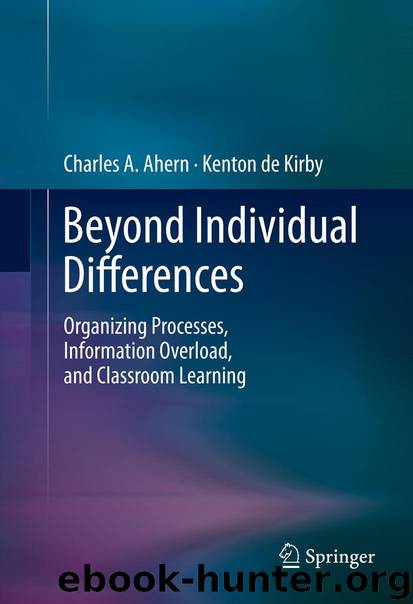Beyond Individual Differences by Charles A. Ahern & Kenton Kirby

Author:Charles A. Ahern & Kenton Kirby
Language: eng
Format: epub
Publisher: Springer New York, New York, NY
Anchor 1: The Learning Goal
We have said that operating from a learning goal is essential. It defines learning episodes, guiding selectivity, set construction and demarcation. In order for a student to encode material effectively and remember it meaningfully, the material must be understood in relation to a learning goal.
This anchor takes as a premise something that I have learned in the course of clinical observation: The nature of a student’s own learning goal is typically available to introspection. While the learning goal is often formed without conscious awareness, one finds that, when cued, students can describe the goal they are working from. This fact provides teachers with an opportunity to develop sensitivity to the extent to which students are operating from a learning goal that supports organizing. In order to cultivate awareness around learning goals, we should first consider students’ learning goals in the ongoing flow or hubbub of the classroom, and make sure we’re clear on what we mean by an effective learning goal in this context.
A good place to begin this discussion about the essential elements of an effective learning goal as they relate to the classroom is by emphasizing that knowledge about the assignment does not, in and of itself, constitute a learning goal. If it did, we’d hardly need to address the importance of cultivating awareness of the learning goal. Teachers routinely discuss learning objectives in all kinds of ways, and students usually have knowledge about what a unit or assignment is about or what the directions are. However, all of this does not necessarily mean that students are working from learning goals in the sense we are using the term. In fact, one important element of awareness about the learning goal is recognizing just how frequently students can operate without one. A student can know a good deal about an assignment unit without necessarily working from a learning goal that is sufficient to inform selectivity and set construction.
So what distinguishes an effective learning goal – one that facilitates meaningful learning – from mere knowledge about the assignment? The most basic consideration is whether students are operating from a goal that is integrally related to learning, as opposed to simply getting the work done. Even students who appear focused and engaged, and who work steadily and with apparent logic, sometimes have no goal in relation to something they wish to learn about or understand more clearly. Instead, their goal is related to what they are doing (e.g., finishing homework, completing an assignment, or being a thorough student), rather than what they are trying to learn. And the surest route to doing without learning is approaching tasks without a clear learning-based goal.
The most important consideration of our first awareness anchor is whether a student has a goal related to learning. But this awareness leads logically to another question: How specific should a learning goal be? This question is perhaps best answered not with any precise definition, but by identifying two important qualities of an effective goal: In
Download
This site does not store any files on its server. We only index and link to content provided by other sites. Please contact the content providers to delete copyright contents if any and email us, we'll remove relevant links or contents immediately.
The Art of Coaching Workbook by Elena Aguilar(50735)
Trainspotting by Irvine Welsh(21407)
Twilight of the Idols With the Antichrist and Ecce Homo by Friedrich Nietzsche(18443)
Fangirl by Rainbow Rowell(9006)
Periodization Training for Sports by Tudor Bompa(8090)
Change Your Questions, Change Your Life by Marilee Adams(7552)
This Is How You Lose Her by Junot Diaz(6694)
Asking the Right Questions: A Guide to Critical Thinking by M. Neil Browne & Stuart M. Keeley(5569)
Grit by Angela Duckworth(5442)
Red Sparrow by Jason Matthews(5317)
Paper Towns by Green John(5018)
Room 212 by Kate Stewart(4956)
Ken Follett - World without end by Ken Follett(4587)
Housekeeping by Marilynne Robinson(4245)
The Sports Rules Book by Human Kinetics(4207)
Papillon (English) by Henri Charrière(4138)
Double Down (Diary of a Wimpy Kid Book 11) by Jeff Kinney(4129)
The Motorcycle Diaries by Ernesto Che Guevara(3925)
Exercise Technique Manual for Resistance Training by National Strength & Conditioning Association(3900)
